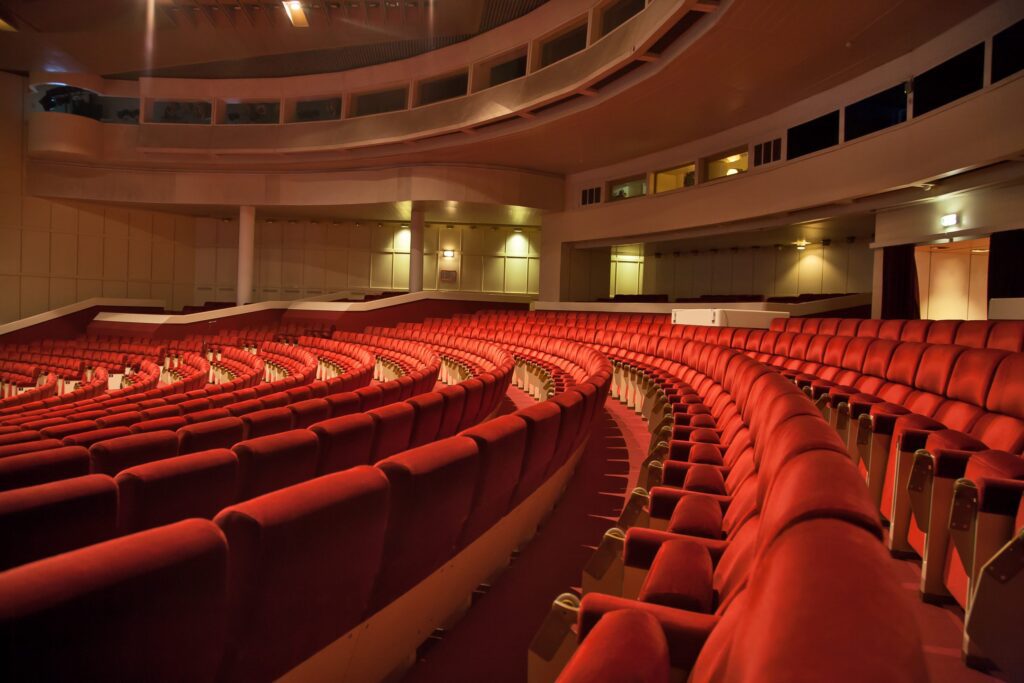Exploring Auditorium Designs: Types, Key Features & Seating Sizes

In the realm of architectural wonders, auditoriums stand as timeless testaments to human creativity and innovation. These spaces aren’t just venues for events; they are immersive experiences where every element, from the design to the seating arrangement, plays a pivotal role in shaping the ambiance and functionality.
At Creative Sports Solutions, we understand the importance of designing auditoriums that not only meet the demands of various events but also leave a lasting impression on attendees. In this blog post, we delve into the diverse world of auditorium designs, exploring their types, key features, and the nuances of seating sizes.
Types of Auditorium Designs
Auditorium designs come in a myriad of forms, each tailored to specific purposes and aesthetics. Here are some of the most common:
Proscenium Auditorium
Characterized by a large arch or frame (the proscenium) separating the stage from the audience, this traditional design offers a clear division between performers and spectators. It’s a classic choice for theatres and concert halls, providing an ideal setting for dramatic productions and musical performances.
Thrust Auditorium
In contrast to the proscenium design, thrust auditoriums feature a stage that extends into the audience, surrounded by seating on three sides. This setup creates an intimate atmosphere, allowing for enhanced interaction between performers and viewers. Thrust auditoriums are popular in lecture halls, small theatres, and educational institutions.
Arena Auditorium
Designed for large-scale events such as sports tournaments, concerts, and conferences, arena auditoriums boast a circular or oval layout with tiered seating surrounding a central performance area. This design maximizes seating capacity while maintaining excellent sightlines from every angle, ensuring an inclusive experience for all attendees.
Black Box Theater
As the name suggests, black box theatres are versatile, adaptable spaces characterized by their simple, unadorned design and configurable seating arrangements. These intimate venues provide a blank canvas for a wide range of performances, from experimental theatre to immersive installations.
Key Features of Auditorium Design
Regardless of the type, successful auditorium designs share several key features that contribute to their functionality and appeal:
Acoustic Considerations
Effective sound management is essential in auditorium design to ensure optimal acoustics for both performers and audience members. This may involve the strategic placement of sound-absorbing materials, adjustable acoustic panels, and specialized ceiling treatments.
Seating Ergonomics
Comfort is paramount in auditorium seating, especially for events that span several hours. Ergonomically designed seats with adequate lumbar support, ample legroom, and optimal sightlines contribute to a more enjoyable experience for attendees.
Flexible Layout Options
The ability to adapt the auditorium layout to accommodate various events and seating configurations is a hallmark of well-designed spaces. Retractable seating, modular platforms, and movable partitions offer versatility and functionality, allowing organizers to tailor the space according to their specific needs.
Accessibility Features
Ensuring accessibility for individuals with disabilities is a crucial aspect of auditorium design. This includes designated wheelchair seating areas, accessible entrances and restrooms, and provisions for assistive listening devices.
Seating Sizes in Auditorium Design
When determining seating sizes in auditorium design, several factors come into play, including the intended use of the space, building codes and regulations, and audience demographics. Seating capacity can vary widely depending on the type of auditorium and its primary function. For example:
- Large-scale venues such as arena auditoriums may accommodate thousands of spectators, necessitating expansive seating arrangements with multiple tiers and aisles to ensure efficient crowd flow and accessibility. In these venues, you’ll commonly find tiered seating with cushioned seats and sturdy armrests, often featuring cup holders for added convenience.
- Intimate theatres and black box venues and black box venues, on the other hand, typically have smaller seating capacities, prioritizing intimacy and close proximity to the performers over sheer volume. In such settings, you might encounter plush, upholstered seats with ample padding and adjustable backs, offering maximum comfort for extended periods of sitting.
- Educational institutions often opt for auditorium designs that strike a balance between capacity and functionality, with seating arrangements tailored to accommodate student assemblies, lectures, and performances. Here, you may find a combination of fixed seating with fold-down desks for note-taking and flexible seating options such as stackable chairs or benches for versatile use.
Auditorium design is a multifaceted endeavour that combines artistic vision with practical considerations to create immersive, functional spaces that inspire and engage. Whether it’s a grand concert hall, an intimate black box theatre, or a versatile multipurpose venue, Creative Sports Solutions is dedicated to providing innovative solutions that elevate the auditorium experience for audiences and performers alike.
